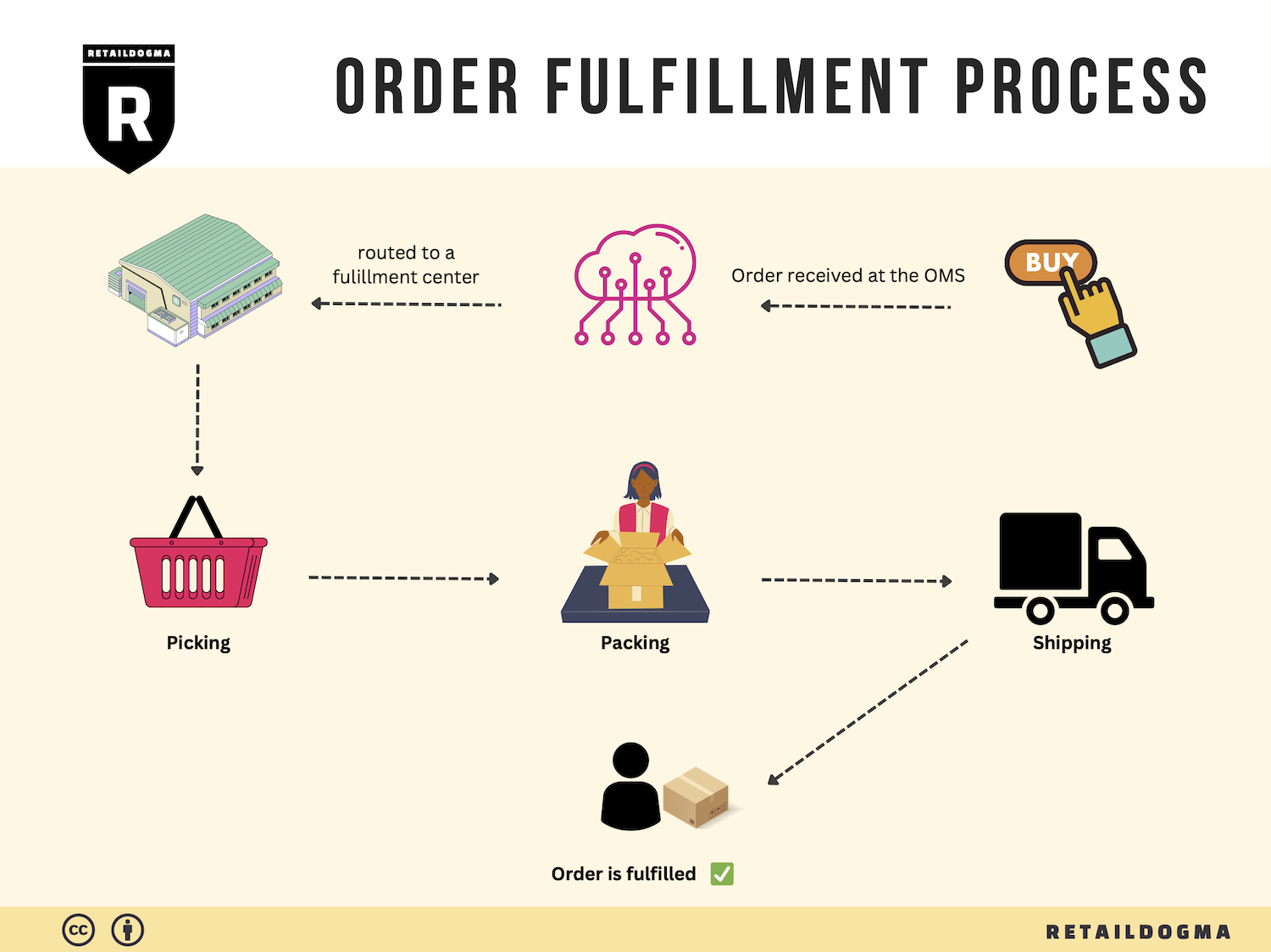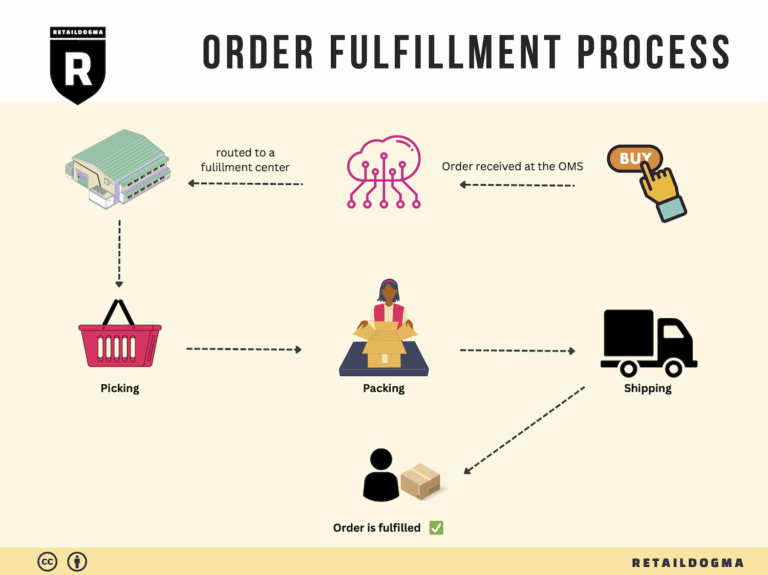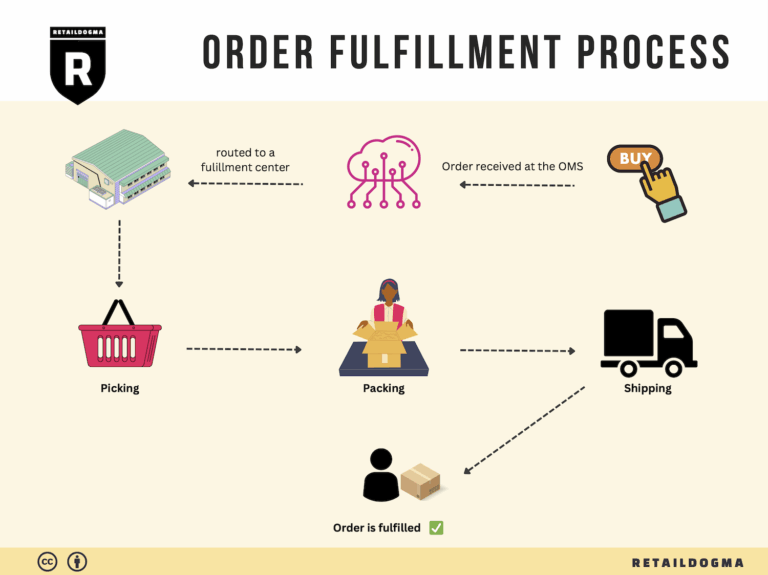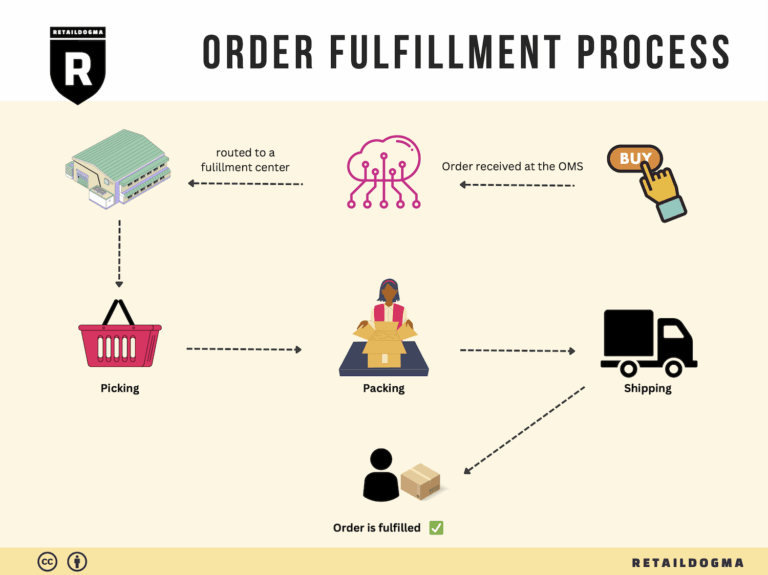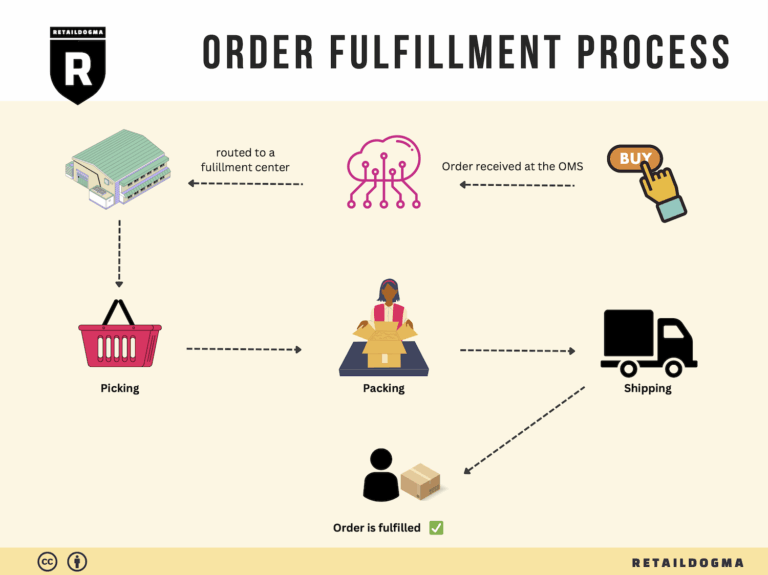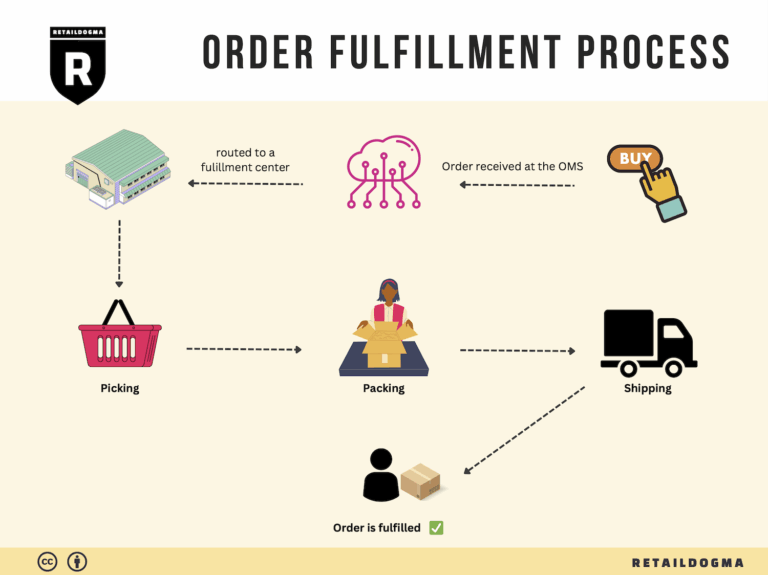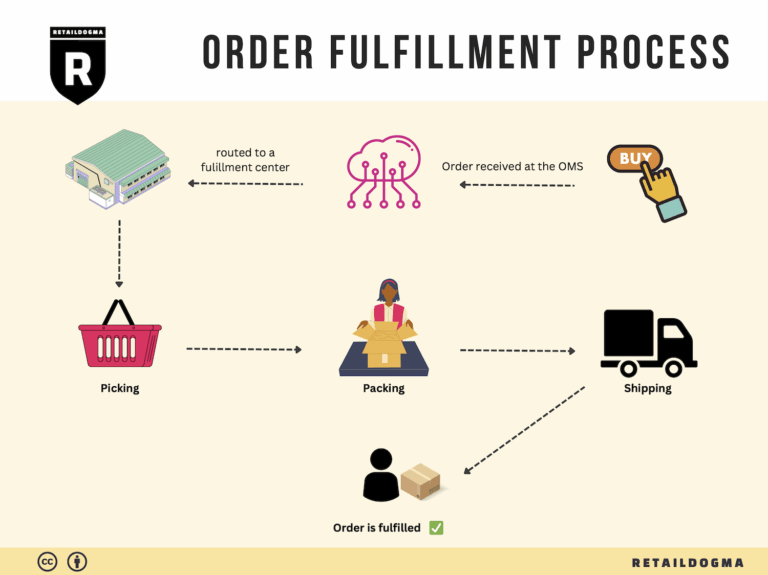How Order Fulfillment Works: A Step-by-Step Guide for Businesses
What is E-commerce Fulfillment? An Introduction for Growing Businesses
Understanding E-commerce Fulfillment: A Practical Guide for Growing Businesses
As your e-commerce business begins to gain traction, the excitement of increased sales can quickly turn into a daunting challenge: managing the packing and shipping of orders. Many entrepreneurs find themselves overwhelmed by the logistics involved in getting products to customers efficiently and effectively. This is where e-commerce fulfillment comes into play, serving as the backbone of your online business operations.
At its core, e-commerce fulfillment is the process of receiving, processing, and delivering products to customers. It encompasses everything from inventory management to packing orders and shipping them out. A streamlined fulfillment process not only improves customer satisfaction by ensuring timely deliveries but also allows you to focus on scaling your business rather than getting bogged down in operational details.
In this guide, we will explore the various models of e-commerce fulfillment available to you, including Third-Party Logistics (3PL) and Fulfillment by Amazon (FBA). Each model has its unique advantages and challenges, and understanding these can help you choose the right approach for your business needs.
We will delve into the core services that fulfillment providers typically offer, such as order processing, inventory storage, packing, shipping, and returns management. Knowing what services to expect can help you assess potential partners and determine what aligns best with your operational goals.
Choosing the right fulfillment partner is crucial for your success. We will provide practical tips on what to look for in a fulfillment provider, including factors such as technology integration, customer service, and scalability. Additionally, we will cover pricing models and how to evaluate costs associated with different fulfillment solutions, allowing you to make informed financial decisions.
Ultimately, this guide aims to empower your business to make smart, strategic decisions about your logistics. By understanding the ins and outs of e-commerce fulfillment, you can streamline your operations, enhance customer experiences, and position your business for sustainable growth in an increasingly competitive market.
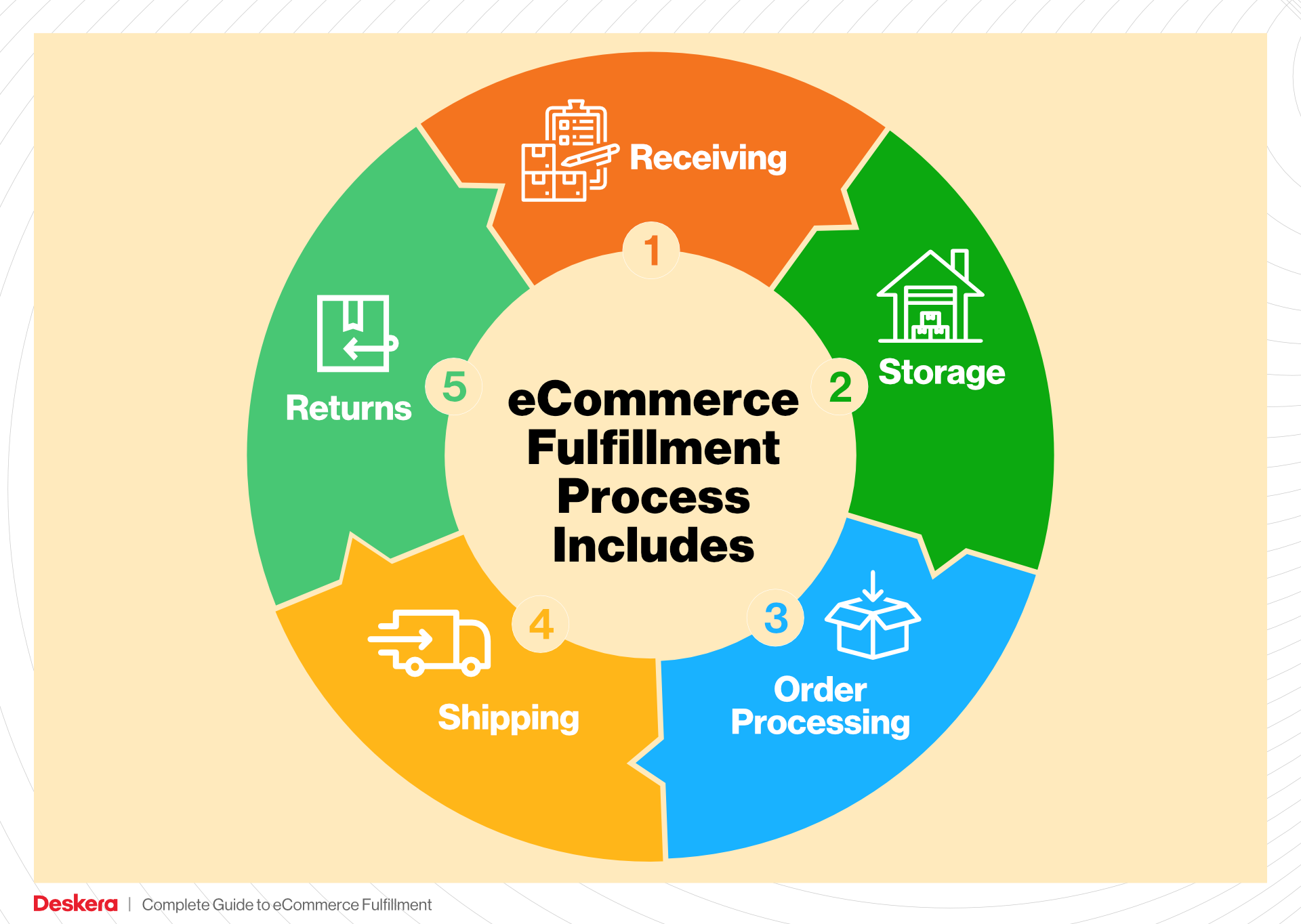
What You’ll Learn In This Guide
- What is E-commerce Fulfillment? An Introduction for Growing Businesses
- The Order Fulfillment Process: From ‘Buy’ Button to Customer’s Door
- Comparing Fulfillment Models: In-House vs. 3PL vs. Dropshipping
- A Deep Dive into Amazon FBA: Pros, Cons, and Who It’s For
- Core Services Offered by Fulfillment Centers
- How to Choose a Fulfillment Partner: A 6-Point Checklist
- Understanding Fulfillment Pricing: A Breakdown of Common Fees
- Frequently Asked Questions (FAQs) about Fulfillment
- Conclusion: Is Outsourcing Fulfillment the Right Move for Your Business?
- Important Disclaimer
The Order Fulfillment Process: From ‘Buy’ Button to Customer’s Door
1. Receiving Inventory
The order fulfillment process begins with receiving inventory from suppliers or manufacturers. This step involves checking the shipment against purchase orders to ensure that the correct quantities and items have been received. It is crucial to inspect for any damages or discrepancies, as this can affect future order fulfillment efficiency.
Key terms associated with this step include SKU (Stock Keeping Unit), which is a unique identifier for each product. Using SKUs helps in tracking inventory accurately and facilitates smooth record-keeping. Efficient inventory receiving sets the stage for streamlined operations downstream, reducing the risk of stockouts and ensuring that products are available when customers place orders.
2. Warehouse Storage
Once the inventory is received and verified, it must be stored appropriately within the warehouse. This step involves organizing products in a manner that maximizes space and minimizes retrieval time. Items are typically stored based on their SKU, and the layout may include zones for fast-moving, slow-moving, and seasonal items.
Effective warehouse storage is vital for maintaining inventory accuracy and optimizing pick times. Warehouse Management Systems (WMS) are key tools here, helping businesses track inventory levels, locations, and movements. Proper storage not only enhances efficiency but also ensures that products remain in good condition until they are needed for order fulfillment.
3. Order Picking
When a customer places an order, the next step is order picking, which involves retrieving the items from storage based on the order details. This process can be done manually or through automated systems, depending on the scale of operations.
The use of pick lists, which outline the items to be collected for each order, is common in this stage. A well-organized picking process is crucial for accuracy and speed. The faster and more accurately items are picked, the quicker the order can be fulfilled. This step directly impacts customer satisfaction, as timely and accurate deliveries are paramount in e-commerce.
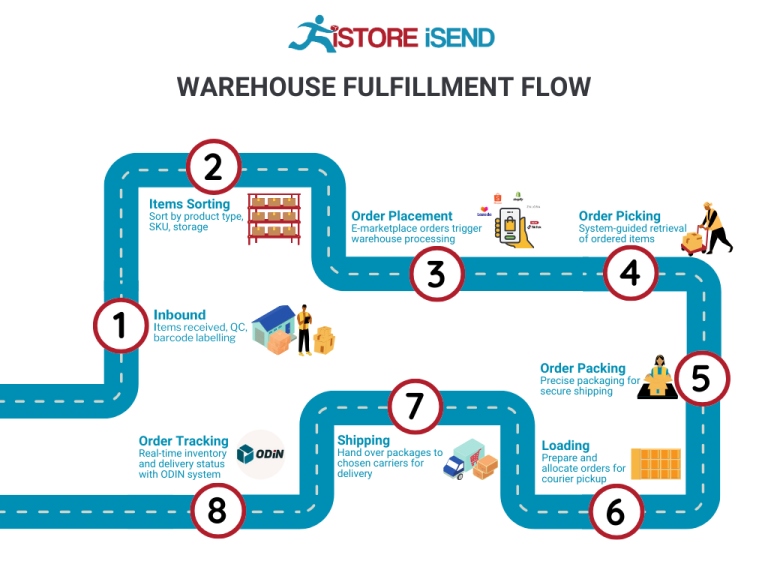
4. Order Packing
After items are picked, they move to the packing station, where they are prepared for shipment. This step includes carefully packaging products to prevent damage during transit. Items may require specific packing materials, such as bubble wrap for fragile items or plastic bags for liquids, to ensure they arrive safely at the customer’s door.
Packing slips are often included with orders, detailing the items purchased, which aids in order verification upon delivery. This stage is critical for maintaining product integrity and enhancing the overall customer experience. An effective packing process minimizes returns and boosts customer confidence in your brand.
5. Shipping & Delivery
The final step in the order fulfillment process is shipping and delivery. Once orders are packed, they are labeled and sorted based on their destination. Shipping methods may vary, including standard shipping, express options, or local delivery services, depending on customer preferences and company capabilities.
Shipping carriers play a vital role in this step, as they are responsible for the physical transportation of goods. Partnering with reliable carriers ensures timely delivery, which is a significant factor in customer satisfaction. Effective shipping and delivery processes not only enhance customer loyalty but also contribute to repeat business, making this step crucial for scaling your e-commerce operations.
In summary, understanding and optimizing each step of the order fulfillment process—from receiving inventory to shipping and delivery—can significantly enhance operational efficiency and customer satisfaction. By focusing on key terms and practices associated with each stage, businesses can create a seamless fulfillment experience that supports growth and scalability.
Comparing Fulfillment Models: In-House vs. 3PL vs. Dropshipping
Fulfillment Models Overview
When it comes to e-commerce, choosing the right fulfillment model is crucial for scaling operations effectively. Here, we compare three primary fulfillment methods: In-House Fulfillment, Third-Party Logistics (3PL), and Dropshipping. Each model has its own set of advantages and disadvantages, making them suitable for different business stages and operational strategies.
| Model | Who Handles Inventory | Best For (Business Stage) | Key Advantage | Key Disadvantage |
|---|---|---|---|---|
| In-House Fulfillment | Business itself | Established businesses with steady sales | Full control over inventory and operations | High overhead costs and labor requirements |
| Third-Party Logistics (3PL) | External logistics provider | Growing businesses expanding reach | Scalable and flexible logistics solutions | Less control over inventory and processes |
| Dropshipping | Supplier | Startups and businesses testing products | Low upfront investment and risk | Lower profit margins and less control over shipping |
In-House Fulfillment
In-house fulfillment means that a business manages its inventory, warehousing, and order processing internally. This model is best suited for established businesses with consistent sales patterns and a well-defined customer base. One of the key advantages of in-house fulfillment is the full control it provides over inventory and operations, allowing businesses to manage quality, shipping times, and customer service directly. This control can enhance the customer experience, fostering loyalty and repeat business.
However, in-house fulfillment also comes with significant challenges. The overhead costs associated with maintaining a warehouse, hiring staff, and managing logistics can be substantial. Businesses must invest in technology and processes to streamline operations, which can strain resources, especially for smaller enterprises. Additionally, scaling operations can become cumbersome as demand increases, often requiring a reevaluation of logistics strategies.
Third-Party Logistics (3PL)
Third-party logistics (3PL) involves outsourcing logistics and fulfillment operations to an external provider. This model is particularly beneficial for growing businesses looking to expand their reach without the heavy investment in warehousing and logistics infrastructure. The primary advantage of using a 3PL is scalability; as demand fluctuates, businesses can easily adjust their logistics services without the need to invest heavily in new facilities or staff.
3PL providers typically have established systems and expertise that can enhance efficiency in shipping and inventory management. This allows businesses to focus on core competencies such as product development and marketing. However, the downside is the loss of direct control over inventory and fulfillment processes. This can lead to potential discrepancies in inventory management and customer service, affecting the overall customer experience. Businesses must carefully select a reliable 3PL partner to mitigate these risks.
Dropshipping
Dropshipping is a fulfillment method where the retailer does not keep products in stock. Instead, when a customer places an order, the retailer purchases the item from a third-party supplier who ships it directly to the customer. This model is ideal for startups and businesses testing new products without significant upfront investment in inventory. The primary advantage of dropshipping is the low risk; businesses do not need to invest in inventory upfront, which minimizes financial exposure.

However, dropshipping also presents challenges, particularly in terms of profit margins. Retailers often face lower margins due to reliance on suppliers for fulfillment, which can lead to pricing pressures. Additionally, businesses have limited control over shipping times and product quality, which can negatively impact customer satisfaction. As such, while dropshipping can be an excellent way to enter the market, businesses should have a solid strategy for managing supplier relationships and customer expectations to ensure long-term success.
Conclusion
Choosing the right fulfillment model is a critical decision for e-commerce businesses aiming to scale effectively. In-house fulfillment offers control but at a higher operational cost, making it suitable for established businesses. 3PL provides a flexible and scalable option for growing companies, while dropshipping allows startups to minimize risk. Each model has its unique advantages and challenges, and understanding these can help business owners make informed decisions that align with their growth strategies and operational capabilities.
A Deep Dive into Amazon FBA: Pros, Cons, and Who It’s For
Understanding Fulfillment by Amazon (FBA)
Fulfillment by Amazon (FBA) is a service offered by Amazon that allows e-commerce sellers to store their products in Amazon’s fulfillment centers. Amazon takes care of storage, packaging, shipping, and customer service for these products. This service streamlines logistics for sellers, enabling them to focus on growing their business while leveraging Amazon’s vast distribution network.
How FBA Works
-
Product Listing: Sellers create listings for their products on Amazon. They can choose to enroll these products in the FBA program.
-
Inventory Shipment: Sellers send their inventory to Amazon’s fulfillment centers. Amazon provides guidelines on how to package and label products for efficient processing.
-
Storage: Once the inventory arrives, it is stored in Amazon’s warehouses. Sellers are charged storage fees based on the amount of space their products occupy.
-
Order Fulfillment: When a customer places an order for a product enrolled in FBA, Amazon picks, packs, and ships the product directly to the customer. This process typically ensures faster delivery times.
-
Customer Service and Returns: Amazon also manages customer service inquiries and handles returns for FBA products, relieving sellers of these responsibilities.
-
Multi-Channel Fulfillment: Sellers can use FBA to fulfill orders from other sales channels, such as their own websites or other marketplaces, expanding their reach beyond Amazon.
Pros of Using FBA
-
Prime Eligibility: Products fulfilled by Amazon are eligible for Amazon Prime, which can significantly increase visibility and sales. Prime members often prefer products that offer free two-day shipping, giving FBA sellers a competitive edge.
-
Customer Trust: Amazon is a well-established brand known for its reliable customer service and fast shipping. When customers see that a product is fulfilled by Amazon, they may feel more confident purchasing it, leading to higher conversion rates.
-
Streamlined Logistics: FBA simplifies the logistics process for sellers. Amazon handles the complexities of storage, shipping, and customer service, allowing sellers to focus on marketing and product development.
-
Multi-Channel Fulfillment: Sellers can leverage FBA to fulfill orders from various sales channels. This means they can sell on their website, eBay, or other marketplaces while using Amazon’s logistics capabilities.
-
Scalability: As sales increase, FBA can easily accommodate the growth without requiring sellers to invest in their own warehousing and fulfillment infrastructure.
Cons of Using FBA
-
High Fees: While FBA provides many advantages, it comes with costs. Sellers incur storage fees based on the volume of inventory stored and fulfillment fees for each order processed. These fees can add up, especially for low-margin products.
-
Strict Inventory Rules: Amazon has specific requirements regarding inventory management, labeling, and storage. Sellers must adhere to these rules to avoid penalties or having their inventory removed.
-
Commingling Risks: FBA products may be commingled, meaning that inventory from different sellers can be mixed together. This can lead to issues if a customer receives a product that is not as described or has quality issues, potentially harming the seller’s reputation.
-
Limited Control Over Shipping: While Amazon handles logistics, sellers have limited control over shipping times and processes. This can be a disadvantage for those who want to maintain a specific brand experience.
-
Potential for Stockouts: If inventory levels are not monitored closely, sellers may run out of stock, which can hurt their sales rankings and visibility on Amazon.
Who is FBA Best For?
Fulfillment by Amazon is particularly well-suited for:
-
Small to Medium-Sized Sellers: Those who do not have the resources to manage their own warehousing and logistics can benefit greatly from FBA.
-
Sellers with High Sales Volume: Businesses that can move a high volume of products can offset FBA fees through increased sales and access to Amazon Prime customers.
-
Brands Seeking Growth: Sellers looking to expand their reach and improve their logistics without the burden of managing fulfillment processes will find FBA advantageous.
-
Entrepreneurs Testing New Products: For those trying out new product lines or markets, FBA provides a low-risk way to scale without significant upfront investment in logistics.
-
Multi-Channel Sellers: Businesses that sell across multiple platforms and want to streamline their fulfillment processes can utilize FBA to handle logistics efficiently.
In conclusion, while Fulfillment by Amazon presents several compelling advantages for e-commerce sellers, it is essential to weigh these against the associated costs and challenges. By understanding the intricacies of FBA, sellers can make informed decisions that align with their business goals and operational capabilities.
Core Services Offered by Fulfillment Centers
Inventory Management & Warehousing
Inventory management is the backbone of any e-commerce business, and fulfillment centers excel at providing robust solutions to maintain optimal stock levels. This service includes tracking inventory levels, managing reorders, and ensuring accurate stock counts. Fulfillment centers utilize advanced technology, such as inventory management software and RFID tagging, to monitor stock in real-time.
The benefits of effective inventory management are manifold. First, it reduces the risk of stockouts, ensuring that your products are available when customers want them. This is crucial for maintaining customer satisfaction and loyalty. Moreover, accurate inventory tracking helps prevent overstock situations, which can lead to increased holding costs and potential markdowns on unsold products. Additionally, fulfillment centers often offer climate-controlled warehousing options, ensuring that sensitive products are stored under optimal conditions, further preserving product quality.
Pick and Pack Services
Pick and pack services are essential for streamlining the order fulfillment process. This service involves selecting products from the warehouse based on customer orders (the “picking” phase) and then packing them securely for shipment (the “packing” phase). Fulfillment centers employ efficient picking strategies, such as batch picking or wave picking, to optimize the process and reduce the time taken to fulfill orders.
The advantages of utilizing pick and pack services are clear. By outsourcing this function to a fulfillment center, e-commerce businesses can significantly reduce labor costs and improve order accuracy. Fulfillment centers are staffed with trained professionals who are adept at handling various products and packaging requirements. This expertise minimizes errors and ensures that items are packed securely, reducing the likelihood of damages during transit. Ultimately, efficient pick and pack services lead to faster delivery times, which can greatly enhance the customer experience and encourage repeat purchases.
Kitting and Assembly
Kitting and assembly services allow businesses to combine multiple products into a single package or kit, which can be an effective strategy for promotional offerings or bundled sales. Fulfillment centers can manage the assembly of these kits, whether they require simple product grouping or complex assembly tasks. This service is particularly beneficial for businesses that sell products that are often purchased together or for those launching new product lines.
The benefits of kitting and assembly are twofold. First, it simplifies the order process for customers, who appreciate the convenience of receiving multiple items in one package. This can lead to increased average order values and improved customer satisfaction. Second, by outsourcing kitting and assembly to a fulfillment center, businesses can focus on their core competencies, such as marketing and product development, rather than logistics. This allows for more efficient resource allocation and can accelerate growth.
Returns Management (Reverse Logistics)
Returns management, or reverse logistics, is a critical service offered by fulfillment centers that involves handling product returns from customers. This includes processing returned items, restocking inventory, and managing customer communications regarding returns. Fulfillment centers utilize established protocols to streamline the returns process, ensuring that it is efficient and customer-friendly.
The importance of effective returns management cannot be overstated. A well-structured returns process enhances customer trust and satisfaction, as customers are more likely to purchase from businesses that offer easy and hassle-free returns. Moreover, fulfillment centers can quickly assess the condition of returned items and determine whether they can be restocked, repaired, or recycled. This minimizes losses associated with returns and contributes to overall inventory accuracy. In a competitive e-commerce landscape, a strong returns management strategy can be a significant differentiator, driving customer loyalty and repeat business.
Conclusion
In summary, the core services offered by fulfillment centers—inventory management and warehousing, pick and pack services, kitting and assembly, and returns management—are indispensable for e-commerce businesses looking to scale their operations efficiently. By leveraging these services, business owners can enhance operational efficiency, improve customer satisfaction, and ultimately drive growth. Partnering with a reliable fulfillment center allows e-commerce businesses to focus on their core competencies while ensuring that their logistics are handled with expertise and precision.
How to Choose a Fulfillment Partner: A 6-Point Checklist
Location & Warehouse Network
The geographical location of your fulfillment partner’s warehouses can significantly affect shipping times, costs, and overall customer satisfaction. A strategically located fulfillment center can ensure faster delivery to your customers, which is crucial in the competitive e-commerce landscape.
Questions to Ask:
– Where are your warehouses located, and how does that align with my target market?
– Do you have multiple locations to cover different regions effectively?
– What is your average shipping time to my primary customer locations?
Technology & Integrations
In today’s digital age, the technology used by your fulfillment partner can enhance efficiency and streamline operations. An effective fulfillment partner should integrate seamlessly with your e-commerce platform, inventory management systems, and other tools.
Questions to Ask:
– What software do you use for inventory management and order processing?
– Can your system integrate with my existing e-commerce platform (e.g., Shopify, WooCommerce)?
– Do you offer real-time tracking for orders, and how is this information communicated to customers?
Specializations (e.g., Cold Storage, Oversized Items)
Your product type may require specific handling or storage capabilities. Whether you need cold storage for perishable goods, special packaging for fragile items, or facilities for oversized products, it’s essential to partner with a fulfillment provider that specializes in your needs.
Questions to Ask:
– What special services do you offer for handling unique products?
– Can you accommodate seasonal inventory fluctuations or special packaging requirements?
– What certifications or compliance measures do you have in place for specific product categories (e.g., food safety regulations)?
Scalability & Capacity
As your business grows, your fulfillment needs will evolve. It’s vital to choose a partner capable of scaling operations to meet increased demand without compromising service quality. A partner with a flexible capacity can help you avoid fulfillment bottlenecks during peak seasons.
Questions to Ask:
– How do you manage fluctuations in order volume, especially during peak seasons?
– What is your maximum capacity for order fulfillment, and how quickly can you scale up if needed?
– Do you have contingency plans in place to handle unexpected spikes in demand?
Pricing and Contracts
Understanding the pricing structure and contract terms of your fulfillment partner is crucial for budgeting and financial forecasting. Look for transparency in pricing and be wary of hidden fees that could impact your margins.
Questions to Ask:
– Can you provide a detailed breakdown of your pricing structure?
– Are there any additional fees for services such as returns, special handling, or storage?
– What are the terms of the contract, and is there flexibility for renegotiation as our business needs change?
Customer Support & Reviews
Reliable customer support is essential for resolving issues quickly and maintaining a smooth operation. Additionally, researching reviews and testimonials can provide insights into a partner’s reliability and service quality.
Questions to Ask:
– What support channels do you offer (e.g., phone, email, chat), and what are your response times?
– Can you provide references or case studies from businesses similar to mine?
– How do you handle issues such as order inaccuracies or shipping delays, and what is your process for communication during such events?
Conclusion
Choosing the right fulfillment partner is a critical decision that can impact your e-commerce business’s efficiency, customer satisfaction, and bottom line. By using this checklist, you can systematically evaluate potential partners to find one that aligns with your operational needs and growth aspirations. Remember, the right partner will not only facilitate your current logistics but also support your business as it scales.
Understanding Fulfillment Pricing: A Breakdown of Common Fees
Initial Setup Fees
When partnering with a fulfillment center, businesses often encounter initial setup fees. These fees cover the costs associated with onboarding your products into the fulfillment system. Typically, this includes creating your account, integrating your e-commerce platform with the fulfillment center’s systems, and setting up product listings.
The calculation of these fees can vary widely based on the complexity of the integration and the volume of products being added. Some fulfillment centers may offer a flat fee, while others might charge based on the number of SKUs (Stock Keeping Units) or the time taken to complete the setup. It’s crucial to discuss these costs upfront to avoid surprises later on.
Receiving Fees
Receiving fees are charged when the fulfillment center accepts your inventory. This fee covers the labor and resources needed to unload, inspect, and organize your products upon arrival.
Receiving fees are typically calculated per pallet or per item, depending on the fulfillment center’s policies. For instance, if you send a shipment of 10 pallets, and the receiving fee is $25 per pallet, your total receiving cost would be $250. Understanding these fees is vital, as they can impact your overall inventory costs significantly, especially during large shipments.
Storage Fees (per pallet/bin)
Storage fees are incurred for keeping your inventory within the fulfillment center. These fees can be charged on a monthly basis and are calculated either per pallet or per bin.
For example, if your inventory occupies 5 pallets and the storage fee is $20 per pallet per month, your monthly storage cost would be $100. It’s essential to keep track of your inventory levels to optimize storage costs, as excess inventory can lead to increased fees. Some fulfillment centers may also offer tiered pricing based on the amount of space you occupy, incentivizing businesses to maintain lean inventory levels.
Pick & Pack Fees (per item/order)
Pick and pack fees are charged for the labor involved in retrieving items from storage and preparing them for shipment. This fee structure can vary based on the number of items in an order or the complexity of the packing process.
Typically, fulfillment centers charge a flat fee per item picked, which might be around $1 to $3, plus an additional packing fee per order. For example, if you have an order containing three items, and the pick fee is $1.50 per item with a packing fee of $2, your total cost for that order would be $6.50. Understanding this fee structure is essential for pricing your products competitively and ensuring profitability.
Shipping Fees
Shipping fees are among the most significant costs in the fulfillment process. These fees cover the expenses associated with delivering your products to customers and can vary based on the shipping method, destination, and package weight.
Fulfillment centers often have negotiated rates with shipping carriers, which can lead to savings for your business. Shipping fees are typically calculated based on the weight and dimensions of the package, along with the chosen shipping method (standard, expedited, etc.). For accurate pricing, it’s advisable to factor in both the fulfillment center’s handling fees and the carrier’s shipping costs when estimating total expenses.
Tips for Getting an Accurate Quote
-
Provide Detailed Information: When seeking quotes, provide comprehensive details about your products, including dimensions, weight, and estimated order volume. This information will help fulfillment centers give you more accurate pricing.
-
Compare Multiple Fulfillment Centers: Don’t settle for the first quote. Compare several fulfillment centers to gauge the average pricing and services offered. Look beyond just costs; consider their technology, customer service, and additional features.
-
Ask About Hidden Fees: Inquire about any potential hidden fees that may apply. Understanding the full scope of costs involved will prevent unexpected expenses down the line.
-
Negotiate Terms: Many fulfillment centers are open to negotiating fees, especially if you anticipate high volumes. Discuss your needs and see if they can provide discounts or better terms.
-
Review Your Needs Regularly: As your business scales, your fulfillment needs may change. Regularly reviewing your fulfillment strategy and associated costs will help you adapt and optimize for efficiency and profitability.
By understanding these common fulfillment pricing models and following these tips, you can make informed decisions that align with your business objectives and budget, ultimately leading to a more streamlined and cost-effective fulfillment process.
Frequently Asked Questions (FAQs) about Fulfillment
1. What is the role of a Fulfillment Expert at Target?
A Fulfillment Expert at Target is responsible for ensuring that online orders are picked, packed, and shipped accurately and efficiently. They engage with customers, manage inventory, and adapt to daily demand fluctuations, all while maintaining high standards of quality and safety.
2. How does the fulfillment process work?
The fulfillment process involves several key steps: receiving orders, picking items from inventory, packing them securely, and shipping them to the customer. Fulfillment Experts utilize tools and technology to track orders and ensure timely delivery, while also preparing for returns and exchanges as needed.
3. What tools do Fulfillment Experts use?
Fulfillment Experts commonly use various tools, including handheld devices for inventory management (like RFID scanners), packing materials, and safety equipment. They also utilize software systems that help track order status and manage inventory levels.
4. What are the key skills required for a Fulfillment Expert?
Key skills for a Fulfillment Expert include strong attention to detail, the ability to work in a fast-paced environment, problem-solving skills, and effective communication. They should also be adaptable to technology and comfortable working both independently and as part of a team.
5. What is the difference between a warehouse and a fulfillment center?
A warehouse is primarily used for storage, while a fulfillment center is designed for processing and shipping orders. Fulfillment centers focus on speed and efficiency in getting products to customers, often handling a higher volume of smaller orders compared to traditional warehouses.
6. What is a Third-Party Logistics Provider (3PL)?
A Third-Party Logistics Provider (3PL) is a company that offers outsourced logistics services, which can include warehousing, fulfillment, and shipping. Businesses often partner with 3PLs to leverage their expertise and resources, enabling them to scale operations without investing heavily in infrastructure.
7. How much do fulfillment services cost?
Fulfillment service costs can vary widely based on factors such as order volume, storage space needed, and shipping methods. Typically, businesses can expect to pay for storage fees, picking and packing fees, and shipping costs. It’s crucial to compare providers and understand the pricing structure to find a solution that fits your budget.
8. How can businesses improve their fulfillment efficiency?
Businesses can improve fulfillment efficiency by optimizing their inventory management, investing in technology (like automated picking systems), training staff effectively, and regularly reviewing processes for potential improvements. Establishing clear communication channels and feedback loops can also enhance overall operations.
9. What safety protocols should Fulfillment Experts follow?
Fulfillment Experts should follow safety protocols that include proper handling of materials, using equipment correctly, adhering to safety guidelines, and reporting hazards. Regular training and compliance checks are essential to maintain a safe working environment.
10. What are some challenges faced in fulfillment operations?
Common challenges in fulfillment operations include managing fluctuating demand, maintaining inventory accuracy, ensuring timely deliveries, and handling returns effectively. Businesses must stay agile and proactive in addressing these challenges to meet customer expectations and sustain growth.
Conclusion: Is Outsourcing Fulfillment the Right Move for Your Business?
Evaluating the Benefits of Outsourcing Fulfillment
Outsourcing fulfillment can be a transformative decision for e-commerce businesses looking to scale efficiently. One of the primary benefits is time savings; by delegating order processing, inventory management, and shipping logistics to a fulfillment partner, you free up valuable hours that can be redirected towards strategic growth initiatives, marketing, and customer engagement. This efficiency allows you to focus on core business activities rather than being bogged down in operational details.
Scalability is another critical advantage of outsourcing. As your business grows, so do your fulfillment needs. A dedicated fulfillment partner can easily adapt to fluctuations in order volume, seasonal spikes, and changes in product lines without the need for you to invest heavily in infrastructure or workforce. This flexibility not only supports your current operations but also positions you for future expansion into new markets or product categories.
Moreover, fulfillment partners bring expertise that can enhance your operational efficiency. They have established systems, technology, and best practices that can lead to faster processing times and improved accuracy in order fulfillment. This expertise is invaluable, especially for businesses without the resources to develop their own logistics solutions.
However, it is crucial to choose the right fulfillment partner. The wrong choice can lead to complications that hinder your growth rather than support it. Look for partners who align with your business values, understand your industry, and can offer tailored solutions to meet your specific needs.
Next Steps for Your Business
To determine if outsourcing fulfillment is the right move for your business, conduct a thorough audit of your current shipping process. Evaluate the efficiency, costs, and scalability of your existing logistics operations. Consider how a fulfillment partner could address any pain points you identify. This strategic assessment will provide clarity on whether it’s time to take the next step towards an outsourced fulfillment solution, ultimately supporting your path to growth and success.
Important Disclaimer
⚠️ Important Disclaimer
The information in this guide is for educational purposes. Fulfillment services, pricing, and platform features change frequently. Always conduct your own due diligence and consult with providers directly before making business decisions.
